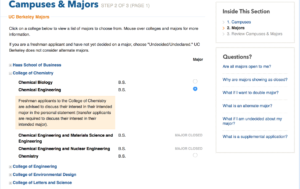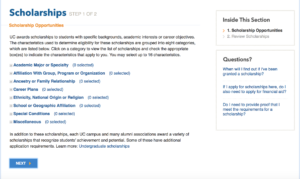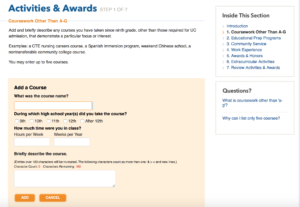The Ultimate Guide to Applying to the University of California
The University of California schools are widely regarded as some of the top public universities in the nation, and it is not difficult to see why. Founded in 1869 in Berkeley, California, the UC system has expanded to include 9 main campuses: Berkeley, Los Angeles, San Diego, Davis, Irvine, Santa Barbara, Santa Cruz, Riverside, and Merced. In addition to these campuses, which operate both undergraduate and graduate schools, UC San Francisco serves graduate students exclusively and is renowned for its top tier medical program.
The UC schools are often praised for their distinguished faculty, cutting edge research, and plentiful academic and personal opportunities afforded to students. UC Berkeley and UCLA are ranked among the top 25 universities in the nation according to U.S. News and World Report, and UC Berkeley is sometimes called the world’s most prestigious public university.
Introducing the UCs
When the University of California was first established in 1869, it was comprised of ten faculty members who educated 38 students. Since then, the system has grown tremendously and is now widely recognized as one of the best university systems in the world.
Today, there are roughly 199,000 students attending a University of California school. The University of California prides itself on being “the only world-class public research university for, by and of California”, and thus it comes as no surprise that a whopping 84.5% of UC students are California residents. 42% of those students are first generation college students, and 27% are members of underrepresented minority groups.
The UC campuses are spread across California, and stretch from Berkeley, in the San Francisco Bay Area, to San Diego, in Southern California. Each individual UC school has its own distinct culture, reputation, and profile. Test scores, average GPAs, and general competitiveness vary quite significantly from school to school. For instance, the average SAT score for students admitted to UC Berkeley is a 2094 out of 2400; for UC Merced, the average is a 1616 out of 2400.
If you are considering attending a University of California school, you should conduct significant research on each specific campus you are interested in to determine whether it may be a good fit. It is important to weigh various factors, from location to campus culture to academic strengths. For instance, the veterinary program at UC Davis is exceptionally strong, and thus UC Davis may be a particularly good fit for a student interested in becoming a veterinarian.
Finances
The average cost of attending a UC for one year varies based on a few different factors; specifically, whether one decides to live on campus, and whether one is a California resident for purposes of tuition.
For California residents living on campus, the estimated total cost of attendance for attending a UC during the 2016-2017 school year is $34,200. If you choose to live off campus, that cost is approximately $30,300. For nonresidents living on campus, the estimated cost of attending is $60,882. For those living off campus, that cost is around $56,982. These numbers are averages across the UC schools, and specific costs and fees vary between school to school.
You may be wondering what it means to be a California resident for purposes of tuition at a UC. There is a difference between this term and and simply being a California resident under other definitions. As the University of California system explains it, “a person who is a California resident for tax or voting purposes is not necessarily a resident for purposes of tuition at the University of California.”
The University of California will ultimately determine whether you are eligible for resident tuition after you’ve been admitted. The UC application contains various questions that are then used to help determine your resident status. Various offices within the system may have various definitions, and it is possible to appeal the decision you receive from a given office by contacting the Office of General Counsel.
The UC schools all offer need based financial aid, and the system recommends that students apply for aid even if they aren’t necessarily sure they will qualify. The financial aid application process is free, and it begins with sending in your general UC application. The application also has a section wherein students are able to apply to several different UC-specific scholarships.
The next step is to submit your FAFSA, or your California Dream Act Application if you are an undocumented student. For this admissions cycle, the deadline to submit these applications is March 2, 2017. Additionally, if you are a California resident or are otherwise eligible for instate tuition, you should verify that your GPA was submitted for a Cal Grant. If you attend a California high school, then your school has probably taken care of this for you. However, it’s still a good idea to check and make sure.
Once you’ve submitted this information, each UC campus you’ve been accepted at will determine your financial aid package and you will receive the award offer electronically. Be aware that UC schools offer both merit and need based aid, and that packages may vary between campus to campus.
Application
All of the University of California schools share a general application. You can send this application to as many or as few campuses as you so desire. There is a $70 fee for every UC campus you choose to apply to. The application filing period is from November 1 – November 30; however, you can access and work on the application before November 1. Note that the UC system does not have an early action or early decision program. You only need to officially report your test scores to one UC campus, and this information will be shared with all of the other campuses you are applying to.
In the first part of the UC application, you’re asked to list general information about yourself. This includes what term you intend on enrolling in, whether you are applying as a freshman or transfer student, your contact information, your residency status, and your citizenship status. This section does not require much elaboration, and the questions are rather straightforward.
In the next section, you are asked about what campuses you are applying to and what major(s) you intend to pursue there. Some UC schools only allow you to select one major, while others give you the option of selecting an alternative major as well. You also have the option of indicating that you are currently undecided. Depending on the major you choose, you may be advised to discuss your passion for the major you’ve selected in your personal statement. You should certainly heed this advice, as this will increase your chances of admission, especially for impacted majors.

If you are applying to UC San Diego, you will also be prompted to rank the university’s colleges in your order of preference. At UCSD, “colleges are residential neighborhoods on campus with their own residence facilities, staff, traditions and general education requirements. Every UC San Diego undergraduate is assigned to one of six colleges when they are admitted to UC San Diego.”

Next, you’ll have the opportunity to review the different UC-specific scholarships. These scholarships are awarded to students who match certain identified characteristics. There are scholarships available in eight categories: academic major or specialty; affiliation with group, program, or organization; ancestry or family relationship; career plans, ethnicity, national origin or religion; school or geographic affiliation; or special conditions, and miscellaneous. Students can select a maximum of sixteen characteristics. You will find out if you’ve been granted a scholarship upon admission.

In the next section, you will answer questions regarding your personal information, parent information, and family size and income. These questions are relatively simple, and bear some similarities to questions asked on the Common Application. You are encouraged to check out the CollegeVine guides on the applicable Common App section if are unsure about how to answer these types of questions.

After this comes the Academic History section, wherein you’ll report relevant information about your academic record. This section asks for information on your middle school (7th and 8th grade), high school, and college courses, if applicable. You’ll also report your high school(s) name and information.

While filling out this section, it is important to keep in mind the University of California’s academic requirements, which are also known as the A-G requirements. These include:
- Two years of history/social science
- Four years of English
- Three years of mathematics
- Two year of laboratory science
- Two years of a language other than English (“*or equivalent to the 2nd level of high school instruction”)
- One year of visual and performing arts
- One year of a college preparatory elective, which can be chosen from the above subjects or be another course that has been approved by the university
Applicants must also have at least a 3.0 GPA for California residents, or a 3.4 GPA for nonresidents. Students also must not have earned any grade lower than a C. The questions in the Academic History section are designed to verify that applicants have met these requirements for admission.
In this section, you also have the opportunity to provide additional comments if there is anything you would like the UC admissions officers to consider while reviewing your academic history. International students who have a different grading system also have the opportunity to describe their high school’s system in this section.
Next, you’ll report your activities and awards. You can report various experiences in this section, and the University of California collects information on the following: coursework other than A-G, educational preparation programs, volunteer and community service, work experience, awards and honors, and extracurricular activities. You can include up to five entries in each category, and have 160 characters to describe the entry. Thus, it is important to both be succinct and prioritize what you feel will contribute the most to your application.

After this, you will encounter the test scores section. Here, you will have the opportunity to report your ACT and/or SAT scores. In addition to this, you will have to officially send your scores to one UC campus, after which it will be shared with the other campuses you are applying to. You can also report your SAT Subject test scores, AP test scores, IB exam scores, TOEFL/IELTS scores if you are from a country where English is not the main language of instruction, and international external exams.
Finally, the last section of the UC application is the Personal Insight section. Here, you will respond to four of the following eight prompts:
- Describe an example of your leadership experience in which you have positively influenced others, helped resolve disputes, or contributed to group efforts over time.
- Every person has a creative side, and it can be expressed in many ways: problem solving, original and innovative thinking, and artistically, to name a few. Describe how you express your creative side.
- What would you say is your greatest talent or skill? How have you developed and demonstrated that talent over time?
- Describe how you have taken advantage of a significant educational opportunity or worked to overcome an educational barrier you have faced.
- Describe the most significant challenge you have faced and the steps you have taken to overcome this challenge. How has this challenge affected your academic achievement?
- Describe your favorite academic subject and explain how it has influenced you.
- What have you done to make your school or your community a better place?
- What is the one thing that you think sets you apart from other candidates applying to the University of California?
Responses are limited to a maximum of 350 words, and you can choose whatever four prompts you feel most drawn towards. No prompt is regarded more highly than another. For more advice on how to answer the UC’s essay questions, check out our guide here.
It should also be noted that UC Berkeley sometimes requests a supplement from selected applicants. Usually, these supplement requests are sent to students who mentioned extenuating circumstances, special talents, disabilities, and other factors. Applicants will be emailed by UC Berkeley if they are selected to provide a supplement.
Generally, applicants are asked to answer questions about their specific additional factor. Students are also asked to report their grades from their first semester of senior year, and provide a letter of recommendation from a teacher or counselor. This supplement is unique to UC Berkeley, and is simply intended to collect more information from the applicant.
Hearing Back
When you’ll hear back from a UC school depends on that specific campus. For instance, historically, UC Santa Cruz has tended to release admissions decisions in mid March. In comparison, UC Berkeley generally releases decisions closer to the end of March. As a general rule of thumb, you will receive your decision between March 1 – March 31.
If you are ultimately rejected, it is possible to appeal your decision. Some campuses also allow waitlisted students to appeal their decision. However, appeals are handled on a case by case basis and reversed admissions decisions based on appeals are extremely uncommon. Successful appeals are rare, but often contain relevant information on extenuating circumstances that were not present in the initial application, or reveal new academic and personal information, such as higher test scores that were not reflected on the initial application. The appeal must demonstrate that the student is in fact a stronger candidate than the earlier application had indicated. Additionally, the appeals process varies from campus to campus, and thus you are encouraged to look into each campus’ specific policy if you are considering appealing.
Waitlisted students will learn of their final status over the summer. If you are waitlisted at multiple UC campuses, you are able to accept a spot on as many waitlists as you so desire. Your chances of getting off the waitlist are influenced by a variety of factors, the most important of which are how many admitted students accepted their offer of admission, and the campus’ specific enrollment goals. Additionally, you are not able to submit additional information unless it has been specifically requested by the campus.
UC Berkeley also operates a unique program titled January Start. Under this program, UC Berkeley admits students who then begin their Berkeley education in the spring semester. Students are not eligible to start in the fall semester, and Berkeley suggests various options that students may choose to pursue during the fall. This ranges from enrolling in a community college after receiving approval from your Berkeley admissions officer, to working a job, to simply taking a break.
If you are admitted, your acceptance is still technically provisional until the UC campus you plan on attending receives your final official transcript, and can verify that you have successfully completed all courses necessary for UC eligibility. If you do not fulfill these terms, or if you experience a significant grade drop, you risk having your acceptance rescinded.
The University of California schools offer students exciting academic and personal opportunities. Every year, these schools attract top students who comprise a top notch applicant pool. While the application process to the University of California schools may initially seem rather daunting, we hope that this guide has helped to answer some of your questions regarding the UC application. We at CollegeVine wish the best of luck with your application!
Curious about your chances of acceptance to your dream school? Our free chancing engine takes into account your GPA, test scores, extracurriculars, and other data to predict your odds of acceptance at over 500 colleges across the U.S. We’ll also let you know how you stack up against other applicants and how you can improve your profile. Sign up for your free CollegeVine account today to get started!


